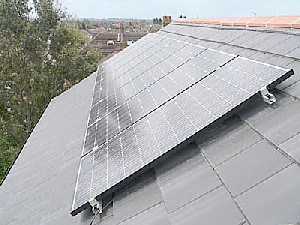How Are Solar Panels Made
Photovoltaic Solar Panels are the main source of domestic renewable electricity in Europe. Costing more per watt of electricity generated than wind power, solar panels have no moving parts and a lifetime of 30-40 years making them ideal for professional installation with virtually no maintenance required by the homeowner.
Crystalline and Amorphous Solar Panels
Their are two main types of solar panel: crystalline and amorphous. In both cases the key ingredient is silicon. Amorphous panels are typically cheaper to manufacture (and purchase), less susceptible to breakage, and use less silicon, however their power output is typically lower than crystalline panels meaning that an amorphous solar installation would take up more space than a similarly power-rated crystalline installation. Amorphous solar panels deteriorate faster than crystallinesolar panels and so their power output will fall more quickly during the years of use.What is Silicon
Silicon (Si) is an abundant non-metallic chemical element which makes up almost 30% of the earth's crust and is the 7th most common element in the Universe. Silicon has two forms - amorphous (brown), and crystalline (dark).
Crystalline Solar Panel Manufacture
To make the solar cells which make up a crystalline solar panel, crystalline silicon is sliced into thin disks (aka wafers) a few millimeters thick or thinner. These are then cut to shape, polished, and any holes in the filled to make the finished wafer uniform.In order to generate electricity, dopants (contaminants) have to be added to the pure silicon wafer. Typically a layer of phosphorous is coated onto the wafer and the surface is heated. Phosphorous atoms then diffuse throughout the silicon wafer contaminating it as required.
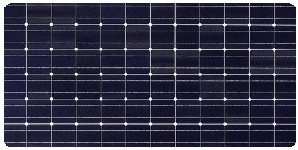
The doped silicon wafers are then aligned together to make up a solar cell, and the solar cells are arranged on a backing panel to make a solar panel (or module). Conductive metal strips are fixed to the sunward face of each solar cell (pictured below).
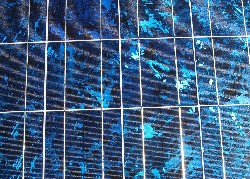
Finally a layer of glass is glued over the top of the collection of solar cells to provide protection from the elements while still permitting sunlight to pass through to the completed crystalline solar module.
Amorphous Solar Panel Manufacture
Unlike crystalline solar panels, amorphous panels are not made up of a collection of interconnected solar cells manufactured from expensive crystalline silicon . Instead a very thin homogenous layer of silicon atoms and dopants is simply sprayed onto a backing material - typically glass or metal, but also on plastic surfaces to make flexible solar panels, or on roofing tiles to make solar roof tiles. The silicon layer produced can be 100 times thinner than the silion wafers in a typical crystalline solar cell greatly reducing material costs.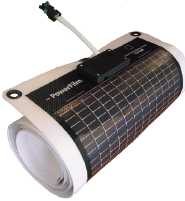
An entire solar module is made in one go, so manufacturing costs are reduced by a) not having the expense of making silicon wafers, and b) the simplicity of assembly.
Amorphous solar panel manufacture only really kicked off in the 1970's and many experts see future developments in amorphous panels as key to bringing down the costs of solar power .
Multi-junction solar cells for example are a recent development in amorphous solar technology using multiple thin layers of doped silicon to capture energy across the whole light spectrum. Multi-junction cells are the most efficient solar cells being manufactured today.
Advantages Of Solar Energy
Solar energy i.e. energy from the sun provide consistent and steady source of solar power througout the year. As our natural resources set to decline in the years to come, its important for the whole world to move towards renewable sources. The main benefit of solar energy that it can be easily deployed by both home and business users as it does not require any huge set up like in case of wind and geothermal power stations. Solar energy not only benefits individual owners, but also benefit environment as well.
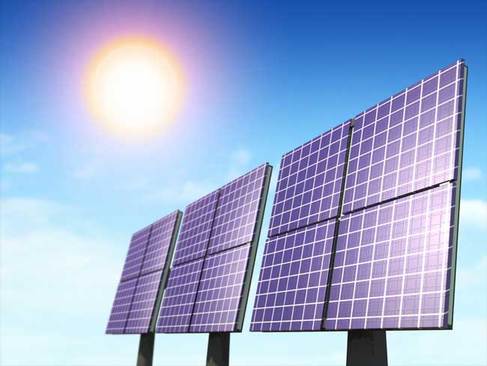
- No Pollution : Solar energy is non-polluting, clean, reliable and renewable source of electricity. It does not pollute the air by releasing harmful gases like carbon dioxide, nitrogen oxide and sulphur oxide. Solar energy does not require and fuel and thus avoid the problems of transportation of fuel or the storage of radioactive waste.
- Long lasting solar cells : Solar cells make no noise at all and there are no moving parts in solar cells which makes them long lasting and require very little maintenance. Solar energy provides cost effective solutions to energy problems where there is no electricity at all.
- Renewable Source : Solar energy is a renewable source of energy and will continue to produce electricity as long as sun exists. Although solar energy can not be produce during night and cloudy days but it can be used again and again during day time. Solar energy from sun is consistent and constant power source and can be used to harness power in remote locations.
- Low maintenance : Solar cells generally doesn't require any maintenance and run for long time. More solar panels can be added from time to time when needed. Although, solar panels have initial cost but there are no recurring costs. Initial cost that is incurred once can be recovered in the long run. Apart from this, solar panels does not create any noise and does not release offensive smell.
- Easy Installation : Solar panels are easy to install and does not require any wires, cords or power sources. Unlike wind and geothermal power stations which require them to be tied with drilling machines, solar panels does not require them and can be installed on the rooftops which means no new space is needed and each home or business user can generate their own electricity. Moreover, they can be installed in distributed fashion which means no large scale installations are needed.




